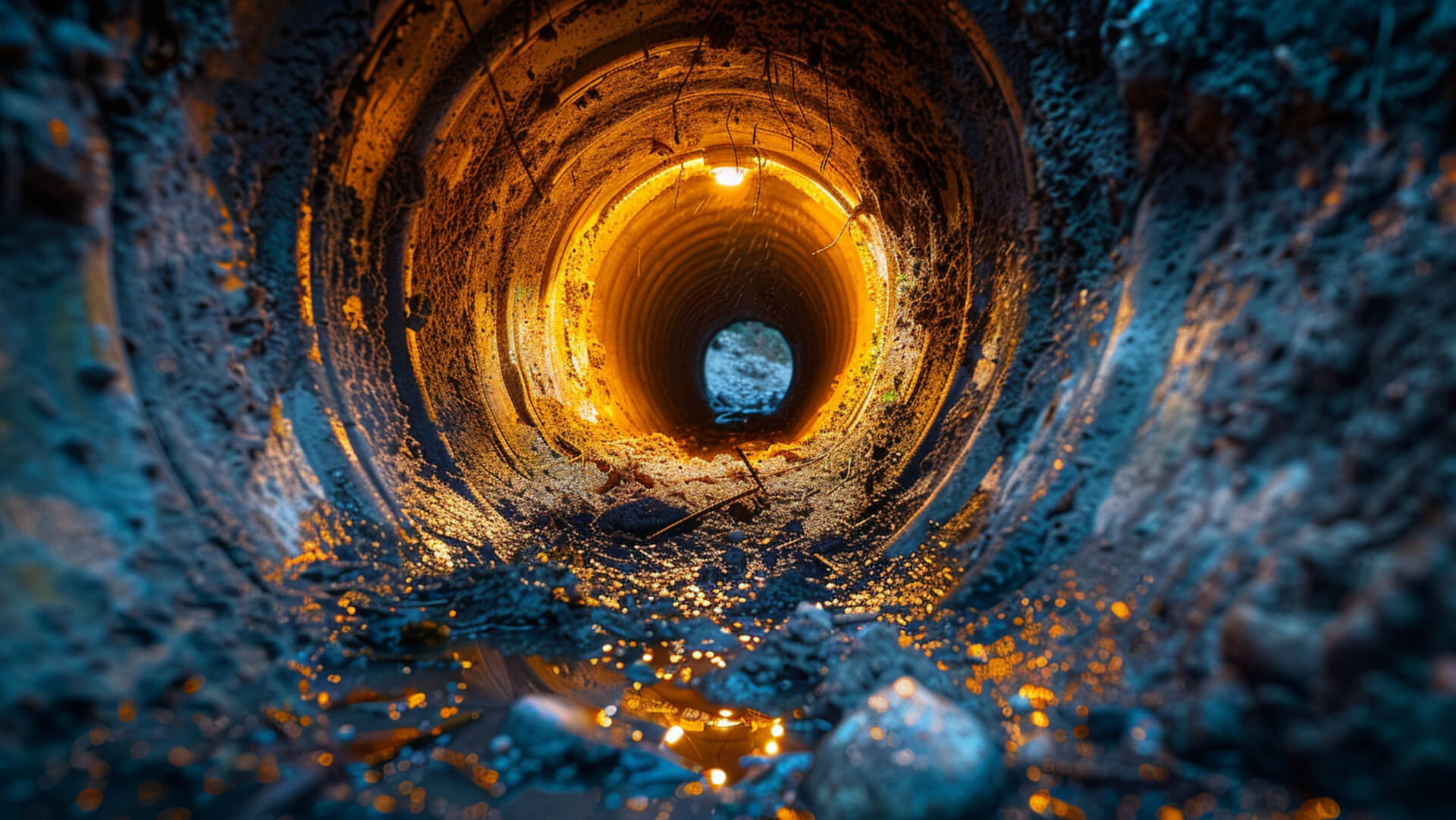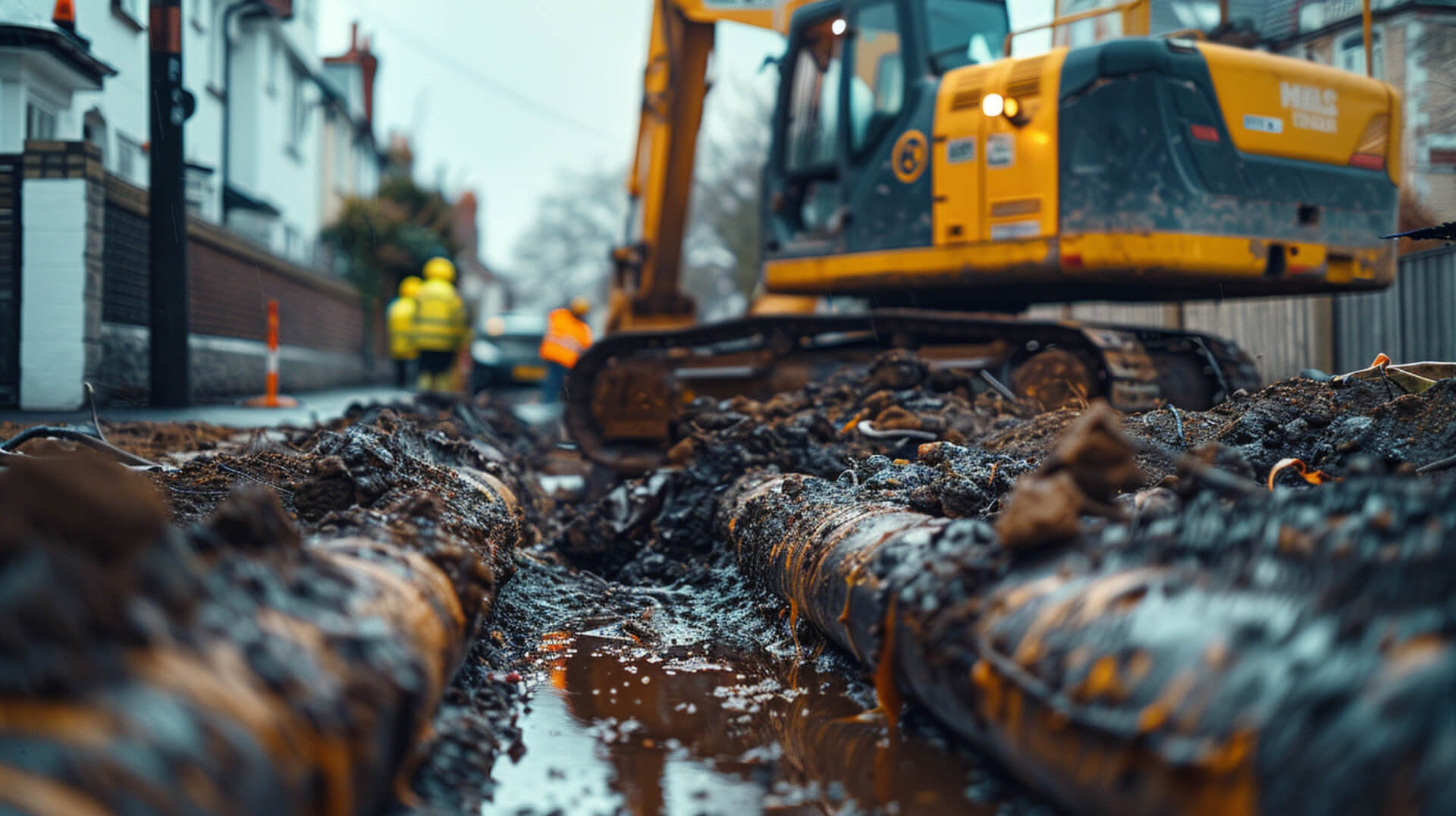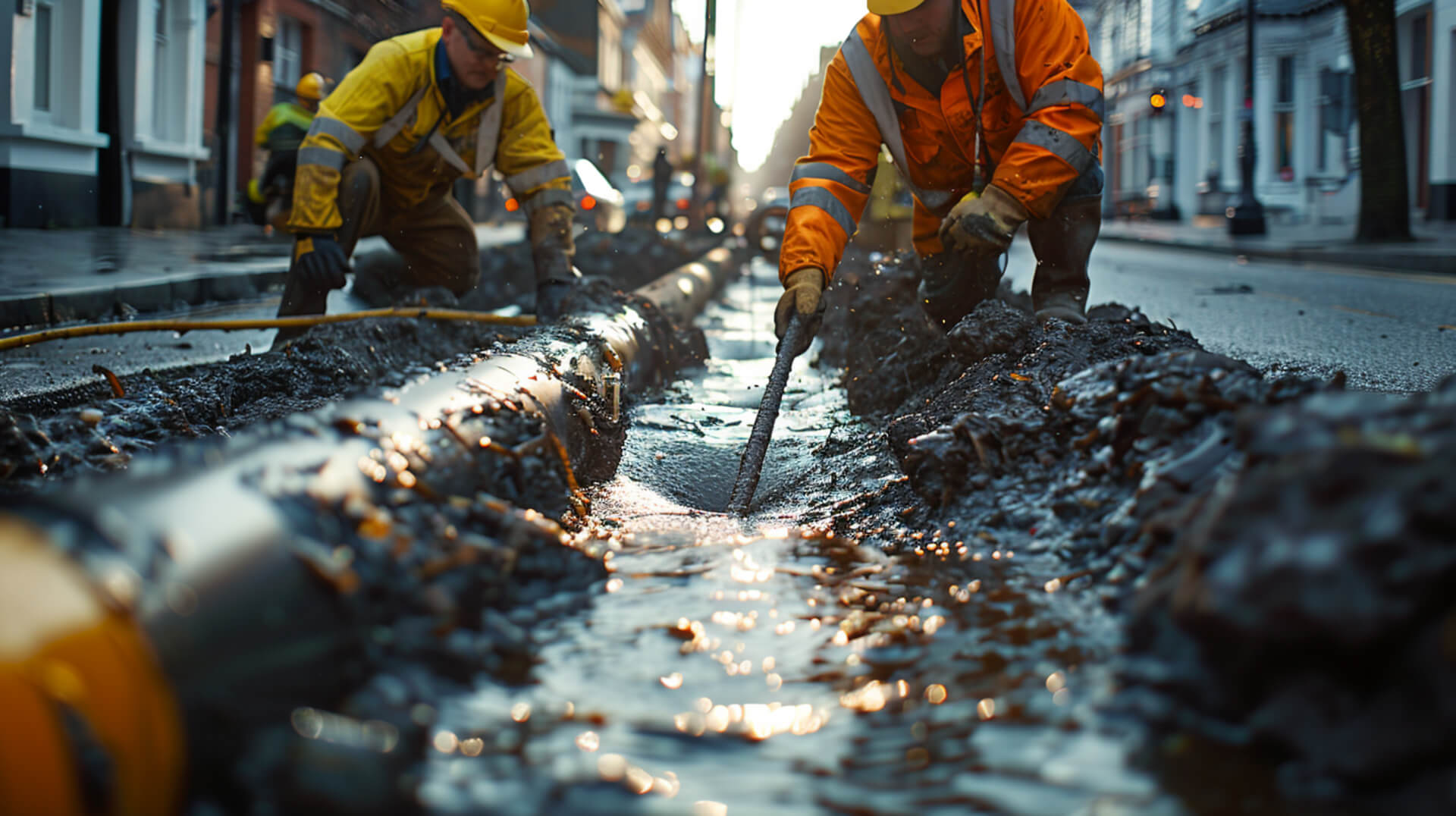 What Is The Process Of Drain Excavation
What Is The Process Of Drain Excavation

Drain excavation is a significant procedure often necessitated by severe drainage system failures. It involves the strategic removal of earth to access underground utilities for repair or replacement. This method is typically employed when other less invasive techniques are insufficient to resolve the issue.
When Is Drain Excavation the Best Option?
Drain excavation is considered a last resort due to its invasive nature. It becomes the best option when the drainage system suffers from extensive damage that cannot be remedied by non-invasive methods like jetting or CCTV surveys. Situations warranting excavation include collapsed drains, severe root intrusion, or irreparable pipe damage.
Comparing Drain Excavation to Other Solutions
Unlike trenchless repair methods, drain excavation is a more traditional approach requiring open trenching. While trenchless technologies offer minimal disruption by repairing pipes internally, excavation is necessary for comprehensive access to the affected drainage infrastructure.
Who Requires Drain Excavation Services?
Property owners, business owners, and facility managers may require drain excavation services when faced with significant drainage problems that impact structural integrity or when the system’s function is compromised beyond the scope of less invasive repair methods.
Recognising the Need for Drain Excavation

Identifying when drain excavation is necessary can prevent further damage to your property’s drainage system. Certain signs serve as indicators that excavation may be the appropriate course of action.
Signs Indicating Drain Excavation
If you’re experiencing persistent slow drainage or frequent clogs, these issues may suggest more severe problems within your drainage system that simple remedies cannot address. Such persistent symptoms often point towards a need for a more invasive solution like excavation.
Sewer Gas Odour as a Red Flag
The presence of sewer gas odour is a clear warning sign. It indicates that there may be a serious breach in the sewer line, which could necessitate excavation to repair or replace the compromised sections of the pipeline.
Abnormal Vegetation Growth
Unusual vegetation growth near your drainage lines can be a symptom of leakage or failure. Excess moisture from a compromised drain can provide a fertile environment for plants, signalling the potential need for excavation.
By paying attention to these signs, you can take timely action to address drainage issues before they escalate. Drain excavation, while more invasive, can be a necessary step to ensure the long-term functionality of your property’s drainage system.
Exploring Non-Invasive Alternatives to Drain Excavation

Before resorting to the more invasive drain excavation, it’s prudent to consider non-invasive methods that can effectively address drainage issues with minimal disruption.
High-Tech Tools and Non-Invasive Methods
Non-invasive alternatives to drain excavation utilise advanced technology to diagnose and potentially resolve drainage problems. These methods are less disruptive and often more cost-effective.
Jetting Equipment and CCTV Surveys
Jetting equipment uses high-pressure water streams to clear blockages within pipes, while CCTV surveys involve inserting a camera into the drainage system to visually inspect for damage or obstructions. These techniques allow for a thorough assessment without the need for immediate excavation.
Trenchless Technologies for Property Owners
Trenchless technologies, such as pipe lining or bursting, are suitable for repairing pipes without extensive digging. Property owners should consider these options when the structural integrity of the drain is intact, and the damage is localised.
Preference for Non-Invasive Methods
For less severe drainage issues, non-invasive methods are preferred due to their efficiency and reduced impact on the property. They provide a means to address problems quickly and with less environmental impact than traditional excavation.
The Comprehensive Process of Drain Excavation

Drain excavation is a significant undertaking that involves several critical steps to ensure the integrity of the property and the safety of all involved.
Site Assessment and Safety Planning
Prior to any excavation, a thorough site assessment is conducted. This includes identifying the exact location of the problem and planning the excavation to avoid any existing underground utilities. Safety planning is paramount, encompassing measures to prevent utility damage and to ensure the protection of workers and the property.
Conducting Repairs or Replacements
During the excavation process, damaged pipes are either repaired or replaced. The choice between repair or replacement is determined by the extent of the damage and the condition of the existing pipes. All actions taken are in compliance with industry standards and regulations to ensure a lasting solution.
Site Restoration Post-Excavation
Once the necessary repairs or replacements are completed, the focus shifts to restoring the site. This involves careful backfilling, compacting the soil to prevent subsidence, and reinstating the site’s aesthetics. The goal is to leave the property in a condition as close to its original state as possible.
By adhering to these steps, drain excavation can be performed effectively, minimising the impact on the property and ensuring a return to proper functionality.
Embracing Efficiency with No-Dig Drain Repair Techniques

In the realm of drain excavation, efficiency and minimal disruption are key. Modern methods have been developed to address these concerns, with a focus on no-dig techniques.
Prioritising No-Dig Techniques
No-dig or trenchless repair methods are increasingly favoured for their ability to fix pipes without extensive excavation. These methods include:
- Cured-in-Place Pipe (CIPP) Lining: A resin-saturated liner is inserted into the damaged pipe and cured to form a new pipe within the old one.
- Pipe Bursting: A bursting head fractures the old pipe outward as a new pipe is pulled through.
Minimising Disruption
These modern methods are designed to minimise the impact on the surrounding environment and your daily operations. By avoiding large trenches, these techniques reduce the amount of debris and downtime associated with traditional excavation.
Essential Equipment for Modern Excavation
The equipment used in no-dig repairs is specialised and less invasive:
- CCTV Cameras: For internal inspection of pipes to accurately diagnose issues.
- Hydro Jetters: For clearing blockages with high-pressure water streams.
Preference for Modern Methods in Complex Cases
For complex drainage issues, modern no-dig methods are preferred due to their:
- Reduced Environmental Impact: Less soil disturbance and lower risk of damaging nearby infrastructure.
- Cost-Effectiveness: Often more affordable due to less labour and time required.
- Long-Term Solutions: Durable repairs that are comparable to traditional excavation methods.
By opting for these advanced techniques, you can ensure a more efficient and less intrusive solution to your drainage problems.
Understanding the Causes of Drainage System Failures

Drain excavation is often a necessary response to a range of underlying issues that compromise the integrity of drainage systems. Recognising these causes is essential for property owners, business owners, and facility managers to make informed decisions about their drainage maintenance and repair strategies.
Corrosion and Soil Conditions
Corrosion of pipes, often due to age or the presence of chemicals in the soil, can lead to the deterioration of drainage systems. Adverse soil conditions, such as high acidity or extreme moisture levels, can also accelerate pipe degradation, making excavation and replacement necessary.
The Impact of Subsidence and Flooding
Subsidence, the gradual caving in or sinking of an area of land, can cause significant damage to underground pipes, leading to misalignment or breakage. Similarly, flooding can overwhelm drainage systems, causing damage that may only be repairable through excavation.
Tree Root Intrusion
Tree roots seeking moisture can infiltrate and damage pipes, leading to blockages or even collapse. These roots can exert considerable pressure on pipes, necessitating excavation to remove the roots and repair the damage they have caused.
Severe Blockages and Structural Damage
When drainage systems experience severe blockages or structural damages, such as collapsed pipes, excavation becomes the only viable solution. This level of damage requires a comprehensive approach to ensure the functionality and safety of the drainage system.
Prioritising Safety During Drain Excavation

Safety is paramount in the process of drain excavation. It encompasses a range of practices designed to protect workers and prevent damage to utilities.
Measures to Prevent Utility Damage
To avoid utility damage during excavation, professionals conduct thorough utility mapping and use precision equipment to locate underground services. This pre-emptive step ensures that the excavation does not interfere with existing infrastructure such as gas, water, or electrical lines.
Mitigating the Risk of Subsidence
Subsidence poses a significant risk during excavation. To mitigate this, engineers assess soil stability and use shoring techniques to support the excavation site. This prevents the collapse of the surrounding area, maintaining the integrity of the excavation and the safety of the workers.
The Crucial Role of Personal Protective Equipment
Personal protective equipment (PPE) is essential for the safety of all personnel on site. This includes helmets, safety glasses, gloves, and high-visibility clothing, which are mandatory to minimise the risk of injury.
Training and Monitoring for Safety Compliance
Workers receive regular training on the latest safety protocols and are monitored to ensure compliance. This ongoing education helps to maintain a safe working environment and reduces the likelihood of accidents.
Understanding the Costs Associated with Drain Excavation

When considering drain excavation, understanding the financial implications is crucial. The cost is influenced by various factors, each contributing to the final estimate.
Factors Influencing Excavation Costs
The overall cost of drain excavation is not a fixed number; it varies based on several elements:
- Labour Intensity: The manpower required for the excavation process.
- Safety Measures: Investments in safety protocols and equipment to protect workers and the property.
- Complexity of the Task: Difficulties faced due to the location of the pipes, depth of excavation, and the extent of damage.
The Role of Complexity in Pricing
The more complex the excavation task, the higher the cost. This complexity can arise from:
- Depth of Pipes: Deeper pipes require more extensive excavation and, therefore, more resources.
- Proximity to Other Utilities: The need to navigate around existing infrastructure adds to the complexity.
Importance of Detailed Planning
Detailed planning is essential for accurate cost estimation. It involves:
- Permit Acquisition: Ensuring all necessary permissions are in place, which may incur fees.
- Utility Mapping: Pre-excavation assessments to avoid utility damage, which can prevent costly repairs.
Financial Considerations for Property Owners
Property owners should be aware of:
- Potential for Additional Repairs: Unforeseen issues may arise during excavation, impacting the budget.
- Long-Term Benefits: While initial costs may be high, proper excavation can prevent future expenses related to drainage issues.
By considering these factors, you can prepare for the financial aspects of drain excavation and make informed decisions about your property’s maintenance needs.
Implementing Maintenance and Prevention Post-Excavation

After completing a drain excavation, it is essential to adopt maintenance and prevention strategies to safeguard the longevity of your drainage system and avoid future issues.
Regular Checks to Prevent Drainage Issues
Regular inspections of your drainage system can identify potential problems before they escalate. These checks should include looking for signs of blockages, assessing pipe conditions, and ensuring that water flows freely.
Importance of Proper Waste Disposal
Avoiding the disposal of non-degradable waste down the drains is crucial. Materials like fats, oils, and wipes can cause significant blockages and damage over time, leading to the need for further excavation.
Extending Drainage System Lifespan
To extend the lifespan of your drainage system, consider:
- Regular Cleaning: Keep drains clear of debris to prevent clogs.
- Professional Assessments: Have professionals conduct periodic evaluations of the system’s integrity.
Long-Term Cost Savings with Prevention Strategies
Investing in prevention strategies can lead to substantial long-term savings by reducing the likelihood of severe blockages and the need for costly repairs or additional excavation. It is a proactive approach that ensures the efficient operation of your drainage system.
Planning and Regulatory Compliance for Drain Excavation

Proper planning and adherence to regulatory compliance are critical components of the drain excavation process. They ensure the project proceeds safely, legally, and with minimal risk to the environment and existing infrastructure.
Navigating Permit Requirements
Before beginning an excavation project, it is essential to secure the necessary permits. These permits are typically issued by local authorities and ensure that the excavation work complies with regional regulations and standards. As a property owner, you’re responsible for obtaining these permits, which may vary depending on the scope and location of the project.
Conducting Utility Mapping
Utility mapping is a precautionary step that involves identifying and marking the location of all underground utilities. This process helps to avoid accidental damage to gas lines, water pipes, or electrical cables, which could lead to service disruptions or hazardous situations.
The Importance of Emergency Preparedness
Emergency preparedness is integral to the excavation plan. It involves establishing protocols to respond to potential accidents or unexpected findings during excavation, ensuring the safety of workers and the public.
Adhering to Excavation Regulations
Compliance with excavation regulations is mandatory. These regulations cover a range of considerations, from environmental protection measures to worker safety standards. Adherence to these rules not only protects against legal repercussions but also upholds the integrity of the excavation process.
The Role of Professional Services in Drain Excavation

Engaging professional services for drain excavation is a decision that can significantly affect the outcome and efficiency of the project.
Assessing the Need for Excavation
Professionals begin with a comprehensive assessment to determine the necessity of excavation. This involves using diagnostic tools such as CCTV surveys to inspect the condition of pipes and identify the exact cause and location of the problem.
Benefits of Professional Excavation Services
Professional services bring numerous benefits:
- Efficiency: Experts are equipped with the knowledge and tools to perform the job quickly and effectively.
- Safety: Professionals adhere to strict safety standards to protect workers and your property.
- Quality: Experienced technicians ensure that the repairs are durable and of high quality.
Ensuring Minimal Environmental Impact
Professionals are committed to minimising the environmental impact of excavation. They employ techniques that reduce soil disturbance and carefully manage material disposal. Additionally, they strive to preserve the surrounding landscape and restore the excavation site to its original condition or better.
By choosing professional excavation services, you ensure that the work is done with precision, safety, and a commitment to environmental stewardship.
Key Takeaways on Drain Excavation

Understanding the process of drain excavation is crucial for property owners, business owners, and facility managers. It enables informed decision-making, which can prevent future drainage issues and ensure the longevity of the property’s infrastructure.
Importance of Understanding the Excavation Process
Knowledge of the excavation process helps you:
- Recognise early signs of drainage problems.
- Evaluate the necessity for excavation versus non-invasive methods.
- Understand the safety measures and planning involved in such a project.
Preventing Future Drainage Issues
Informed decisions based on a clear understanding of drainage systems can lead to:
- Proactive maintenance and regular inspections.
- Swift action when signs of damage or blockage are detected.
- Consideration of long-term implications of drainage solutions.
Seeking Further Advice and Services
For further advice or professional services regarding drain excavation, consider:
- Consulting with licenced and experienced drainage companies.
- Engaging with professionals who can provide comprehensive assessments and tailored solutions.
- Utilising resources such as industry associations for recommendations and guidance.
By staying informed and consulting with professionals, you can ensure that any necessary excavation is conducted safely, efficiently, and with minimal disruption to your property.


